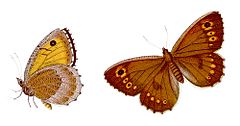
The meadow brown is a butterfly found in the Palearctic realm. Its range includes Europe south of 62°N, Russia eastwards to the Urals, Asia Minor, Iraq, Iran, North Africa and the Canary Islands. The larvae feed on grasses.

Apatura ilia, the lesser purple emperor, is a species of butterfly native to most of Europe and east across the Palearctic. It is named for its similarity to the purple emperor butterfly.

Erebia epistygne, the spring ringlet, is a species of butterfly in the family Nymphalidae. It is found in France and Spain. Its natural habitat is temperate grassland.

The Lapland ringlet is a member of the subfamily Satyrinae of the family Nymphalidae. It is restricted to sunny patches in very damp spruce and pine forests and forested unmanaged peatlands. The larva feeds on various grasses and related plants and winters twice. A dry period in the habitat will result in the decline of the species.

The Piedmont ringlet is a member of the family Nymphalidae. It is an Alpine butterfly.
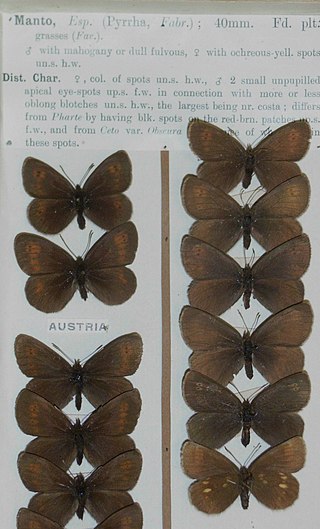
The yellow-spotted ringlet is a member of the subfamily Satyrinae of the family Nymphalidae. It is associated with (sub)alpine meadows at 900–2,500 m above sea level. It is found in the Alps, the Pyrenees, the Cantabrian Mountains, the Massif Central, the Vosges Mountains, the Carpathian Mountains and the mountains of Herzegovina.
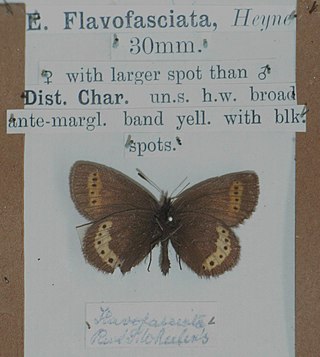
The yellow-banded ringlet is a member of the subfamily Satyrinae of the family Nymphalidae. It is a high mountain butterfly found in a small area of the Alps in Switzerland and Italy.
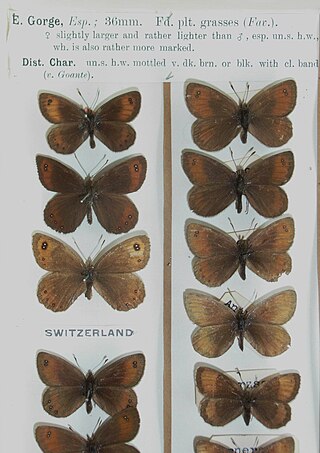
The silky ringlet is a member of the subfamily Satyrinae of the family Nymphalidae. It is a high-altitude butterfly found on screes in the Alps, Pyrenees, central Italy and the Balkans. It is a very variable butterfly.

The marbled ringlet is a member of the subfamily Satyrinae of the family Nymphalidae.

The de Prunner's ringlet is a member of the subfamily Satyrinae of the family Nymphalidae.

The black ringlet is a member of the subfamily Satyrinae of the family Nymphalidae. It is a high-altitude butterfly found in Albania, former Yugoslavia, Bulgaria, Greece, and Romania.

Chazara briseis, the hermit, is a butterfly species belonging to the family Nymphalidae. It can be found in North Africa, southern Europe, Asia Minor, the Caucasus, Kazakhstan, Central Asia through Afghanistan, and north-western China and Tuva. It is found on steppe and in other dry grassy places between 500 and 2,500 meters.

Erebia pandrose, the dewy ringlet, is a member of the subfamily Satyrinae of the family Nymphalidae. It is found from the Arctic areas of northern Europe, the Pyrenees, Alps, the Apennine Mountains, the Carpathian Mountains, Kola Peninsula and Kanin Peninsula, part of the Ural and the Altai and Sayan Mountains up to Mongolia.

Erebia melampus, the lesser mountain ringlet, is a member of the subfamily Satyrinae of the family Nymphalidae.

Pseudochazara anthelea is a species of butterfly in the family Nymphalidae. It is found in Albania, the Republic of Macedonia, Bulgaria, Greece, Turkey and northern Iraq. The males can be easily distinguished from the females by the white base and they are found in dry, stony slopes and gullies, usually on limestone.
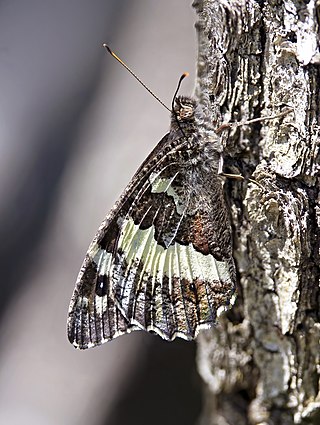
Brintesia is a monotypic butterfly genus in the family Nymphalidae and subfamily Satyrinae. Its one species is Brintesia circe, the great banded grayling.

Chazara persephone, the dark rockbrown, is a butterfly species belonging to the family Nymphalidae. It can be found from Crimea across the Caucasus and north of the Middle East to Iran; from the southern Urals across Kazakhstan to the southern Altai and west Siberia.

Pseudochazara beroe is a species of butterfly in the family Nymphalidae. It is found from western Turkey across southern Transcaucasia and the Elburz Mountains to Kopet-Dagh.
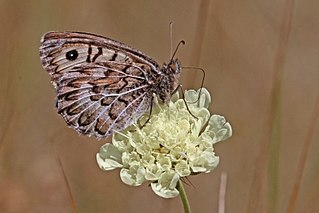
Pseudochazara geyeri, the Grey Asian grayling is a species of butterfly in the family Nymphalidae. It is confined to Albania, Greece, North Macedonia, eastern Turkey and south-western Transcaucasia.
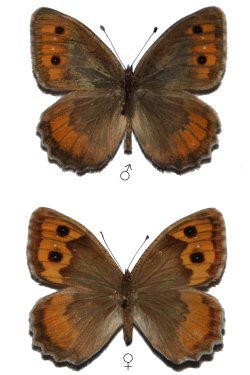
Pseudochazara mniszechii, the tawny rockbrown, is a species of butterfly in the family Nymphalidae. It is confined to Greece, Turkey, northern Iran, Balochistan, and the Caucasus.




